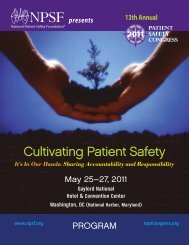NPSF Research Grants Program - NPSF Patient Safety Congress
NPSF Research Grants Program - NPSF Patient Safety Congress
NPSF Research Grants Program - NPSF Patient Safety Congress
Create successful ePaper yourself
Turn your PDF publications into a flip-book with our unique Google optimized e-Paper software.
RESEARCH POSTERS<br />
R-1 American College of Surgeons: Surgical<br />
<strong>Patient</strong> Education Skills <strong>Program</strong> is Effective<br />
at Preparing <strong>Patient</strong>s to Confidently<br />
Manage Their Post-Operative Recovery<br />
R-2 Baylor University Medical Center: Golden<br />
Hour...One Unit’s Experience<br />
R-3 Baylor University Medical Center: System-<br />
Wide Implementation of a NICU Central<br />
Line Bundle: Practice Changes Associated<br />
with a Decrease in Infection Rates<br />
R-4 Christiana Care Health System: Post Event<br />
Debrief: A Commitment to Better Care of<br />
our <strong>Patient</strong>s and Staff (facts as known)<br />
R-5 cmi/Compas: Ramifications of Web-Based<br />
Health Assessment Tools on Consumer<br />
Behaviors and Health Outcomes<br />
R-6 Dana-Farber Cancer Institute: Advancing<br />
the Culture of <strong>Safety</strong>: DFCI version 2.0<br />
R-7 Dialog Medical: <strong>Patient</strong>s as <strong>Safety</strong><br />
Partners: Best Practices for <strong>Patient</strong>-<br />
Centered Communications<br />
R-8 Doctors Hospital of Manteca : Safe and<br />
Accurate Compounding While Meeting<br />
Requirements of Recent California Law<br />
R-9 Eisenhower Medical Center: Does Bar<br />
Code Administration Systems Improve<br />
<strong>Patient</strong> <strong>Safety</strong>: A Nurse’s Perspective<br />
R-10 Hennepin County Medical Center/<br />
University of Minnesota: Obstacles to<br />
Voluntary Reporting of Medical Errors in<br />
an Inpatient Setting<br />
R-11 Johns Hopkins Psychiatry Department:<br />
Rapid Response in Psychiatry<br />
SOLUTIONS POSTERS<br />
S-1 Kaiser Permanente - Southern California<br />
Permanente Medical Group: Using FMEA and<br />
RCA of Simulation Events to Create a Risk<br />
Analysis Tool and Simulation Curricula to<br />
Prevent “Never” Events<br />
S-2 366th Medical Group: <strong>Patient</strong>s Are Our<br />
Partners, Implementation of Shift Change<br />
Bedside Report<br />
S-3 Baltimore VA Medical Center:<br />
A Multidisciplinary Approach to Improve<br />
Compliance with SCIP Measures<br />
S-4 374 MDG Yokota AB, Japan: Reducing the<br />
Risk of MRSA Crosscontamination<br />
S-5 Abington Memorial Hospital: Making the<br />
Most of Benchmarking by Optimizing<br />
Resources during the Prevalence Study to<br />
Improve <strong>Patient</strong> Outcomes<br />
2012 <strong>NPSF</strong> POSTER PRESENTATIONS<br />
R-12 Massachusetts General Hospital: Surgeons’<br />
Hazardous Attitudes are Associated with<br />
Readmission and Reoperation Rates<br />
R-13 Mayo Clinic: Does High-Fidelity Simulation<br />
Training Develop Nurse-Physician Teams?<br />
R-14 Mayo Clinic: <strong>Patient</strong> Risk Factors for Adverse<br />
Events during Congestive Heart Failure<br />
Hospitalizations<br />
R-15 MedStar Institute for Innovation<br />
The Surgeons’ Leadership Inventory (SLI):<br />
Development of a Behavioral Marker Tool<br />
to Measure Intraoperative Leadership<br />
R-16 Muskie School of Public Service, Univ. of<br />
Southern Maine : SAFER - Standardizing<br />
Admissions for Elderly Residents<br />
R-17 National Center for Human<br />
Factors Engineering in Healthcare:<br />
A Sociotechnical Systems Approach to<br />
Healthcare-Acquired Infections<br />
R-18 Northwestern University, Institute<br />
for Healthcare Studies: Improving<br />
Communication and Team Performance<br />
Using Risk Informed In-Situ Simulation<br />
R-19 NYU Hospital for Joint Diseases:<br />
Rapid Rehab and Discharge Disposition<br />
R-20 NYU Hospital for Joint Diseases:<br />
Wrong Site Surgery: Using Information<br />
Technology for Prevention<br />
R-21 Seattle Children’s Hospital: A Focus on Pain,<br />
the Neglected Adverse Event<br />
R-22 Shands Jacksonville: Faculty Development<br />
Through Simulation <strong>Patient</strong> <strong>Safety</strong> Training<br />
R-23 Steiros: The Steiros Algorithm®; a Global<br />
Environmental Cleaning Process to Dramatically<br />
Reduce Hospital-Acquired Infections<br />
S-6 Beth Israel Medical Center: Managing<br />
Oxytocin Usage for Augmentation or<br />
Induction of Labor<br />
S-7 Baptist Health South Florida: ACT NOW!<br />
Accelerating & Sustaining Change for<br />
<strong>Patient</strong> <strong>Safety</strong><br />
S-8 Baptist Health South Florida: Sustaining<br />
Accountability through Effective <strong>Patient</strong><br />
<strong>Safety</strong> Rounds<br />
S-9 Baylor University Medical Center:<br />
STAT...are you sure of that?<br />
S-10 Baylor University Medical Center Dallas:<br />
“Fab 50”<br />
S-11 Capital Health: Implementation of<br />
a Dedicated Center for Neurological<br />
Emergencies within an Adult ED Setting<br />
R-24 Thomas Jefferson University: Decrease in<br />
Central Venous Catheter Placement and<br />
Related Complications Due to Utilization of<br />
Ultrasound-Guided Peripheral Intravenous<br />
Catheters<br />
R-25 UHC: Central Line–Associated Bloodstream<br />
Infections in ICU: Concurrence between<br />
UHC’s Administrative and NHSN’s<br />
Surveillance Databases<br />
R-26 UHC: An Analysis of Medication-Related<br />
Events in the UHC <strong>Patient</strong> <strong>Safety</strong> Net®<br />
R-27 UHC : Falls Prevention: Do the Findings in<br />
UHC <strong>Patient</strong> <strong>Safety</strong> Net® Support Current<br />
Prevention Strategies?<br />
R-28 VA National Center For <strong>Patient</strong> <strong>Safety</strong>:<br />
2011 Clinical Alarms National Survey<br />
R-29 Beth Israel Medical Center: Oxytocin Usage<br />
for Labor Augmentation or Induction and<br />
Adverse Neonatal Outcomes<br />
R-30 Northwestern University, Institute for<br />
Healthcare Studies: Increasing Medical<br />
Student Primary Care <strong>Patient</strong> <strong>Safety</strong><br />
Awareness Using <strong>Patient</strong> <strong>Safety</strong> Practice Logs<br />
R-31 Northwestern University, Institute for<br />
Healthcare Studies: Assessment and<br />
Communication Challenges in Pediatric<br />
Interfacility Transfers<br />
R-32 Kaiser Permanente - Southern California<br />
Permanente Medical Group: Using<br />
Simulation as a Tool to Decrease<br />
Medication Errors in Pediatric Emergency<br />
Department <strong>Patient</strong>s<br />
S-12 Center for Healthcare Engineering and<br />
<strong>Patient</strong> <strong>Safety</strong>, University of Michigan:<br />
Applying Risk Driven <strong>Patient</strong> <strong>Safety</strong> Systems<br />
in Healthcare<br />
S-13 Chamberlain College of Nursing:<br />
Implementing Nursing Rounds to Improve<br />
Nurse Morale<br />
S-14 Changi General Hospital: <strong>Patient</strong><br />
Identification: Enhancing <strong>Safety</strong> in the<br />
Accident and Emergency Department<br />
S-15 Children’s Hospitals and Clinics of Minnesota:<br />
Preventing Hypoglycemia through<br />
Feedback and Empowering Unit-Based<br />
Quality/<strong>Safety</strong> Teams<br />
S-16 Cleveland Clinic: Cascading Communication:<br />
A Model to Manage <strong>Safety</strong> Event Reporting<br />
Analysis<br />
<strong>Patient</strong> <strong>Safety</strong> 365 23 <strong>NPSF</strong> Annual <strong>Patient</strong> <strong>Safety</strong> <strong>Congress</strong> 2012



